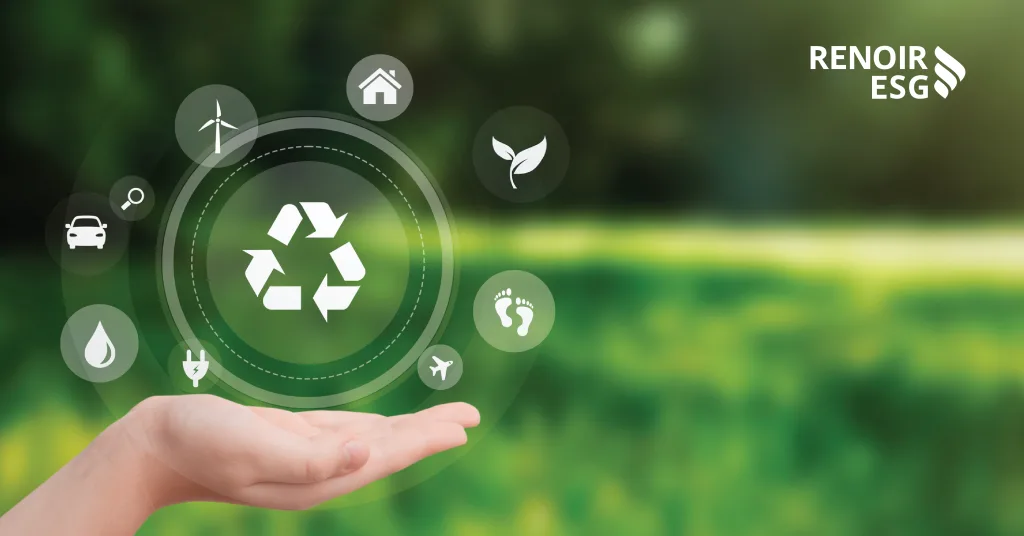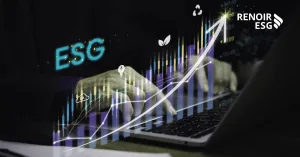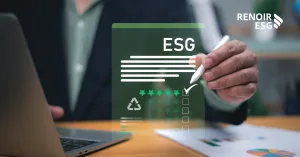At a Glance:
- The circular economy, poised to hit $4.5 trillion by 2030, helps companies cut costs and boost sustainability—some reporting up to 15% production cost savings.
- Many ESG efforts falter by focusing only on reporting. Circular strategies fill this gap by integrating resource efficiency, design innovation, and customer participation into everyday operations.
Keep reading for a full breakdown on How to build a circular strategy and RenoirESG’s implementation framework.
The circular economy is rapidly emerging as a trillion-dollar opportunity, projected to reach $4.5 trillion USD globally by 2030. Companies that have embraced circular economy (CE) practices are already reporting an average 15% reduction in production costs, through lower material usage, improved energy efficiency, and better waste management. One packaging manufacturer, for example, saved nearly $2 million annually by switching to a more efficient production process and reusing raw materials.
What does this mean for sustainability leaders?
This data presents a dual opportunity: cut costs, enhance operational efficiency and sustainability performance. The circular economy enables businesses to move beyond short-term compliance into long-term value creation by rethinking how products are designed, produced, and recovered. Leaders who embrace circularity can reduce operational risk, future-proof their supply chains, and align ESG initiatives with tangible business outcomes.
Unlike the traditional “take-make-dispose” model—which depends on finite resources and creates waste and emissions at every stage—a circular economy strategy is restorative and regenerative by design. It keeps materials in use for longer, maximises their value, and closes the loop through reuse, remanufacturing, and recycling.
In an ESG context, many sustainability strategies fail because they focus on reporting rather than operational change. Circularity fills that gap.
So how do you build one?
How to Build Circular Economy Strategy
“The call for a CE strategy for companies is akin to a ship’s captain deciding to navigate with the prevailing currents rather than against them. The currents of resource scarcity, environmental degradation, and evolving regulations are pushing towards a circular economy. “
– Marlene Johler | TEDxTUWien
A circular economy (CE) strategy goes beyond general sustainability initiatives. While sustainability efforts often focus on reducing harm or improving efficiency, a CE strategy is built on systemic change, targeting the root of environmental and resource issues through design, value retention, and regeneration.
Core Principles of a Circular Economy Strategy
Embed circularity into value creation
Look for ways to shift from selling products to offering outcomes. For instance, providing your product as a service can reduce waste and drive efficiency. Signify’s lighting-as-a-service model, led to more energy-efficient fixtures and reduced energy consumption.
Prioritise high-impact circular actions
Use the “R” hierarchy—refuse, rethink, reduce, reuse, repair, refurbish, remanufacture—before resorting to recycling or recovery. The further “up” the hierarchy an action is, the greater its potential to achieve circularity and retain value.
Design for durability, modularity and return
The design stage is critical, as 80% of a product’s sustainability is determined at this point. This stage ensures products are built to last, be disassembled, and reintroduced into your value chain.
Engage customers in the circular loop
Build models that incentivise return, reuse, or sharing. This enhances loyalty while closing the material loop.
Integrate circular metrics into business KPIs
Integrate circularity into your ESG reporting by aligning it with operational KPIs—track metrics such as recycled input rates, product reuse levels, and emissions avoided through closed-loop systems. For instance, the BMW i3 electric vehicle is made with up to 25% recycled and reusable materials, showcasing the company’s commitment to circular product design.
How Business Leaders Can Build a Circular Economy Roadmap
| Focus Area | Implementation | Business Impact |
| Identify Value Creation Opportunities | Map where circular models (e.g., reuse, leasing, shared use) can unlock new revenue or enhance customer experience | Shifts focus from cost-cutting to growth and innovation |
| Integrate Circularity into Design | Design products for disassembly, reuse, and minimal waste | Embeds circular economy principles at the source |
| Build Cross-Functional Capabilities | Align sustainability, R&D, procurement, and operations | Ensures circular strategy is operationalised company-wide |
| Pilot Circular Business Models | Run small-scale tests (e.g., repair services, take-back schemes) | Validates feasibility and customer response before scaling |
| Collaborate Across the Ecosystem | Partner with suppliers, customers, logistics providers | Enables closed-loop systems and shared innovation |
| Invest in Digital Tools | Use AI, blockchain, or IoT for tracking and performance | Supports traceability, accountability, and scalability |
| Align with ESG Reporting and Policy | Link CE metrics to ESG standards (GRI, CSRD, ISSB) | Meets compliance, enhances transparency, and reduces policy risk |
RenoirESG’s Corporate Circular Economy Strategy Services
At RenoirESG, we specialise in circular economy consulting, helping corporate clients develop a robust circular economy strategy tailored to their operations and regional market context. We provide tools specialising in CE integration, helping companies tailor approaches to their specific maturity level and industry challenge, ensuring practical impact and cultural embedding of circular practices.
Whether you’re expanding into Europe, Asia, or the Middle East, our consultants work with you to design closed-loop systems, embed reuse alongside ESG frameworks, and align sustainable business models with your long-term growth objectives.
Need support to accelerate your corporate circular economy transformation?











